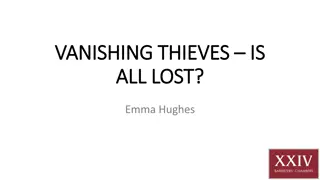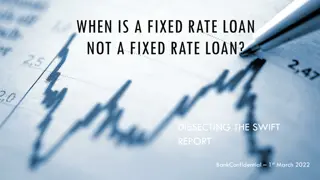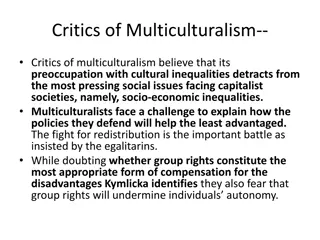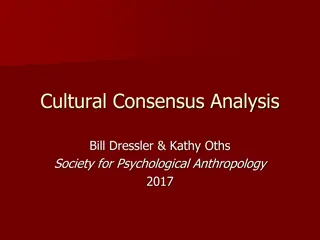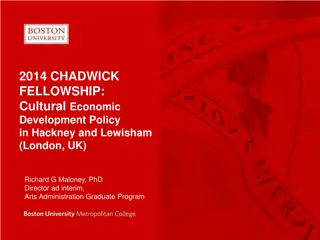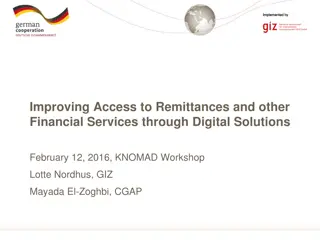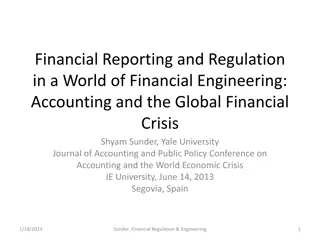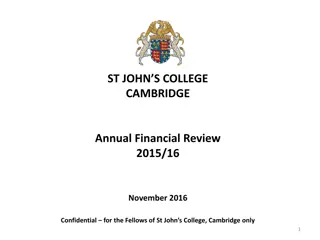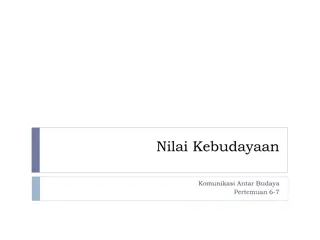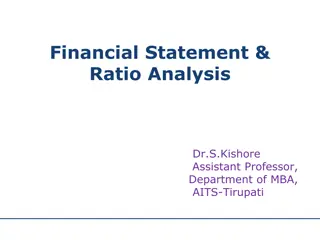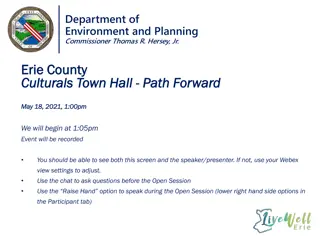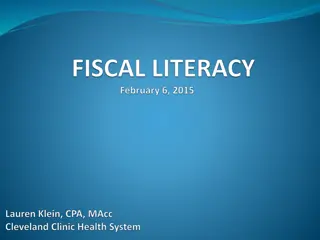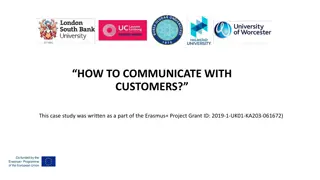Overview of Barclays' Financial Challenges and Cultural Issues
Barclays faces financial challenges and cultural issues in its investment banking division. Despite disappointing financial results, Bob Diamond vowed to improve the return on equity. Tables show the return on equity and assets for Barclays PLC in recent years.
Download Presentation

Please find below an Image/Link to download the presentation.
The content on the website is provided AS IS for your information and personal use only. It may not be sold, licensed, or shared on other websites without obtaining consent from the author. Download presentation by click this link. If you encounter any issues during the download, it is possible that the publisher has removed the file from their server.
E N D
Presentation Transcript
The madness of Barclays Background briefing by cresc researchers cresc.ac.uk
Whats going on? The standard line on Barclays (and investment banking) since the crisis is that it has a cultural problem The long standing CRESC argument is that there is a material problem about the business model in investment banking (which can be illustrated from the Barclays report and accounts) The slides below present a basic briefing in slide form on what s wrong (originally prepared by CRESC in response to a media request for some statistics in May 2012) As the briefing has now been cited in public by national media (eg Guardian, 10 July) after the libor scandal, we have reviewed the argument and are putting it up on the cresc web site; with the proviso that we would ordinarily present a more sophisticated and rounded analysis of company and industry.
Diamond vows to try harder as Barclays disappoints That was how the FT (10 Feb 2012) reported Bob Diamond s presentation of disappointing financial results for 2011 He admitted that the bank had made an unacceptable 6.6 % return on equity, and reiterated his target of 13% which is below what the bank delivered in the mid 2000s (see next slides, comparisons complicated by acquisition of Lehman; first slide gives our calculation, second B s slightly different calculation) I am not satisfied with these returns. I care about this a lot it is important to shareholders. We have a lot more to do If it wasn t for the external factors we could still do it (13% target ROE ) we ll make steady progress next year
Table 9: Barclays PLC Return on equity, assets Return on average shareholder equity % 14.5 12.1 6.5 6.8 5.7 Return on average total assets Return on average total assets Total Pre-tax profit (continuing operations) shareholder equity % 0.4 0.3 0.2 0.3 0.2 % 0.4 0.3 0.2 0.3 0.2 m m 6,254 5,094 4,559 6,079 5,974 2007 2008 2009 2010 2011 31,821 43,574 58,699 62,641 65,170 Source: Barclays 20-F Note: Shareholder equity includes capital injection -note the underlying profit hasn't collapsed Note 2: Total shareholder equity is not the same as average shareholder equity
Table 10: Barclays PLC 2011 Return on equity -supplied by the company Return on average shareholder equity (ADJUSTED) % 14.9 -6.0 10.0 17.4 10.4 1.3 10.9 24.1 -2.9 6.6 Return on average shareholder equity (STATUTORY) % 10.6 -21.8 10.0 6.8 10.4 -1.4 10.9 - 3.3 5.8 UK retail Europe retail Africa retail Barclaycard Barclays Capital Barclays Corporate Barclays Wealth Investment Management Head Office Group Source: Barclays 20-F Adjusted performance measures exclude the impact of own credit gains, gains on debt buy-backs, loss on disposal of a portion of the Group s strategic investment in BlackRock, Inc., impairment of investment in BlackRock, Inc., provision for PPI redress, goodwill impairment and loss/gain on acquisitions and disposals. The adjusted return on average equity and the adjusted return on average tangible equity represent adjusted profit after tax and non-controlling interests (set out on pages 274 to 276) divided by average equity and average tangible equity, excluding the cumulative impact of own credit gains of 2,708m (2010: 391m gain, 2009: 1,820m loss) recognised in Head Office and Other Operations.
Repeating the same mistakes and expecting different results That s how we would characterise the Barclays strategy Remember the strategy for Lehman and Bear Sterns which ended in disaster (a) ramping speculative assets to improve RoE (b) game over and bailout when asset prices fall unpredictably or liquidity fails . But Barclays strategy in 2011 is as before; 3/4 of its assets are in BarCap which now earns a wafer thin 0.3 % return on assets and only half the profit (see next slide); compare the healthier UK retail and Barclaycard businesses which have a higher ROA and a more modest appetite for assets
Table 8: Barclays PLC 2011 segmental analysis -continuing operations Pre-tax income m 2,965 -70 561 1,020 249 1,154 5,879 Assets Return on assets % 0.3 -0.1 1.7 0.8 0.2 2.2 0.4 Share of pre- tax income % 50.4 -1.2 9.5 17.3 4.2 19.6 100.0 Share of assets % 74.1 5.7 2.1 8.2 6.5 3.4 100.0 m Barclays Capital Barclays Corporate Barclaycard UK Retail Other Retail All other Total 1,158,350 88,674 33,383 127,845 102,069 53,206 1,563,527 Source: Barclays 20-F
Wheres the RoA? In the report and accounts: the percent of Barclays income from trading stands no higher than 23% and interest income from old fashioned banking intermediation stands no higher than 37% (both asset intensive). There is a further 26% derived from fees and commissions (less asset intensive traditionally). It may be that like JP Morgan they are increasingly wily about reclassifying their trading, but key question = why does BarCap need to ramp so many assets to generate a paltry RoA ? Put more provocatively: why are those employees paid the most within Barclays investment banking division unable to turn a higher profit on the assets they manage than other Barclays divisions? If intermediary function (and societal contribution) of banks = efficient capital allocation, why are the highest paid the worst performers in this process of allocation? Especially the case when BarCap s speculative assets may be more prone to write-downs historically.
Table 7: Barclays PLC Income by type 2011 m % Interest income Fees and commissions Trading Investment Insurance Gain on buy backs Other Total 12,201 8,622 7,660 2,305 1,076 1,130 39 33,033 36.9 26.1 23.2 7.0 3.3 3.4 0.1 100.0 Source: Barclays 20-F Excludes write-offs Table 7a: Barclays PLC Income by type 2007 m 9,610 7,708 3,759 1,216 1,011 % Interest income Fees and commissions Trading Investment Insurance Gain on buy backs Other Total 40.9 32.8 16.0 5.2 4.3 0.0 0.8 100.0 188 23,492 Source: Barclays 20-F Excludes write-offs
The madness of Barclays The investment banking led business model results in a bloated balance sheet and huge credit risk; In 2011 Barclays credit risk is 1,795 trillion i.e. larger than nominal British GDP of 1,500 trillion; nearly half of that is in derivatives + off balance sheet Barclays net risk is half that size at 794 trillion but that assumes all Barclays counterparties would or could pay up but that depends on the quality of its internal risk models, and whether there is a systemic crisis (see Haldane, A. (2012) Tails of the Unexpected). The euro crisis is a banking crisis because of long chain interconnections through bank lending and derivatives from South to North Europe (CRESC Working Paper 110); against this background Barclays strategy is madness which may cost the taxpayer dear in a further round of bank recapitalisations.
Table 2: Barclays PLC Credit risk split by total and geographic spread TOTAL 2011 GEOGRAPHIC UK Europe Americas Africa & Middle East Asia m % m % share of total m % share of total m % share of total m % share of total m % share of total Derivatives Loans (w/s and h/l) Repos Trading porfolio Off balance sheet Other Total exposure 538,964 431,934 153,665 124,738 292,292 254,011 1,795,604 30.0 24.1 8.6 6.9 16.3 14.1 100.0 173,863 220,815 22,701 15,162 104,576 69,708 606,825 32.3 51.1 14.8 12.2 35.8 27.4 33.8 173,863 90,444 32,926 23,381 35,663 89,636 445,913 32.3 20.9 21.4 18.7 12.2 35.3 24.8 153,629 63,457 80,124 68,835 126,977 57,574 550,596 28.5 14.7 52.1 55.2 43.4 22.7 30.7 4,857 49,309 1,795 3,498 22,870 15,063 97,392 0.9 11.4 1.2 2.8 7.8 5.9 5.4 32,823 7,909 16,119 13,862 2,206 21,959 94,878 6.1 1.8 10.5 11.1 0.8 8.6 5.3 Of which net exposure 794,700 44.3 Source: Barclays 20-F Note: Net exposure relates to exposure with no net counterparty
What have you done for me lately? Taxpayers should ask this question because Barclays is (a) a machine for enriching elite investment bankers with 1.5 billion in staff bonuses last year cf pre tax profit of 3billion (b) the risks to the taxpayer are not offset by corporation tax because Barclays has used losses to minimise its payments; a parliamentary question in early 2011 forced disclosure that Barclays paid just 113 million in UK corporation tax in 2009 Barclays pile of assets continues to do very little for the real economy because of its lending pattern; >60% of PLC / company wide and of UK lending is to other financials and on house mortgages; loans to manufacturing, retail and wholesale account for no more than 7.2 % of the UK loan book and are in nominal terms sharply down on 2007 levels
Barclays PLC: Lending to UK customers (Nominal data -as actually reported) 2007 2011 Nominal increase/ decrease 2007- 2011 % 31.2 -34.1 -4.3 59.1 -27.4 m % m % Finance Manufacturing Construction Property Energy and water Wholesale and retail business Other business Home loans Cards and other personal loans Other 21,131 9,388 3,542 10,203 2,203 11.1 4.9 1.9 5.4 1.2 27,725 6,185 3,391 16,230 1,599 12.0 2.7 1.5 7.0 0.7 13,800 7.2 10,308 4.5 -25.3 22,705 71,755 11.9 37.7 16,473 112,260 7.1 48.7 -27.4 56.4 26,810 14.1 27,409 11.9 2.2 8,810 4.6 8,856 3.8 0.5 Net lending 190,347 100.0 230,436 100.0 21.1 Total non-finance business (ex property) 51,638 27.1 37,956 16.5 -26.5 Source: Barclays PLC annual reports Note: Non-finance business is manufacturing, construction, energy and water, wholesale and retail business, other business.
Alibi or charge sheet? Barclays alibi is that the demand isn t there for real economy loans Our charge sheet is that the real economy is irrelevant because financial reform is inadequate + Barclays remains irresponsible : (a) the firm s strategy is centred on increasing asset volume in more speculative activity in the hope of higher ROE (b) the taxpayer (once again) is placed to foot the bill if or when it all goes wrong


